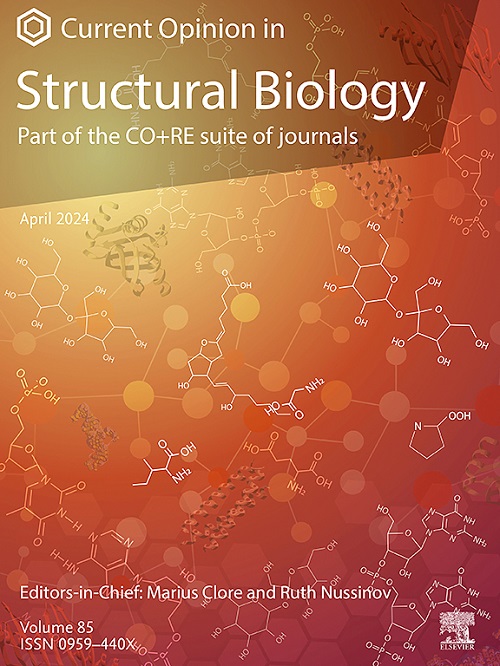降解:弱蛋白相互作用如何使分子胶降解
IF 6.1
2区 生物学
Q1 BIOCHEMISTRY & MOLECULAR BIOLOGY
引用次数: 0
摘要
分子胶是一种类似药物的小分子,可以诱导蛋白质之间的相互作用或促进蛋白质之间先前存在的弱相互作用。在泛素连接酶的情况下,这种结合事件经常通过邻近导致泛素化。然而,这些变革模式的合理发展仍然是一项重大挑战。在这里,我们回顾了最近对分子胶和新兴设计原则的见解。同样,蛋白质表面也可以通过突变或化合物诱导结合,从而获得功能。当两种蛋白质之间的相互作用表面相对较小时,或者当蛋白质之间的亲和力较弱时,化合物将按比例提供更多的结合能来将蛋白质粘合在一起。我们提出了一个简单的热力学模型来解释化合物和突变促进的分子粘合作用。本文章由计算机程序翻译,如有差异,请以英文原文为准。
Primed for degradation: How weak protein interactions enable molecular glue degraders
Molecular glues are small drug-like molecules that induce de novo protein–protein interactions or facilitate pre-existing weak interactions between proteins. In the context of a ubiquitin ligase, such binding events frequently result in ubiquitination by proximity. Rational development of these transformative modalities, however, remains a major challenge. Here we review recent insights into molecular glues and the emerging design principles. Protein surfaces can similarly be complemented by mutations or compounds inducing binding and a resulting gain of functionality. When the interaction surface between two proteins is relatively small, or when the affinity between the proteins is otherwise weak, proportionally more binding energy will have to be provided by the compound to glue the proteins together. We suggest a simple thermodynamic model to rationalize molecular glue action facilitated by compounds and mutations.
求助全文
通过发布文献求助,成功后即可免费获取论文全文。
去求助
来源期刊

Current opinion in structural biology
生物-生化与分子生物学
CiteScore
12.20
自引率
2.90%
发文量
179
审稿时长
6-12 weeks
期刊介绍:
Current Opinion in Structural Biology (COSB) aims to stimulate scientifically grounded, interdisciplinary, multi-scale debate and exchange of ideas. It contains polished, concise and timely reviews and opinions, with particular emphasis on those articles published in the past two years. In addition to describing recent trends, the authors are encouraged to give their subjective opinion of the topics discussed.
In COSB, we help the reader by providing in a systematic manner:
1. The views of experts on current advances in their field in a clear and readable form.
2. Evaluations of the most interesting papers, annotated by experts, from the great wealth of original publications.
[...]
The subject of Structural Biology is divided into twelve themed sections, each of which is reviewed once a year. Each issue contains two sections, and the amount of space devoted to each section is related to its importance.
-Folding and Binding-
Nucleic acids and their protein complexes-
Macromolecular Machines-
Theory and Simulation-
Sequences and Topology-
New constructs and expression of proteins-
Membranes-
Engineering and Design-
Carbohydrate-protein interactions and glycosylation-
Biophysical and molecular biological methods-
Multi-protein assemblies in signalling-
Catalysis and Regulation
 求助内容:
求助内容: 应助结果提醒方式:
应助结果提醒方式:


